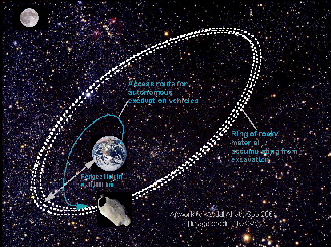 Would a Saturn-like ring system around planet Earth remain stable?
Would a Saturn-like ring system around planet Earth remain stable?[An astronomical paper by A. Ahad]
Copyright © 2004 Abdul Ahad. All rights reserved.
Article posted: 9 October 2004
Dynamical models have shown that the orbit of a particle circling around the Earth will precess (rotate) its line of nodes along the equator over time according to the equation [1]:-
-3/2 * J2 * (R^2 / p^2) * n * cos (i) . . . . . . . . . . . . . . . . . . .(1)
[where J2 is a constant related to Earth's flattening (about 0.001), R is the radius of the Earth (about 6378km), p is the "parameter" of the orbit (= a*(1-e^2)), n is the mean motion of the orbit (=sqrt(mu/a^3)), and i is the inclination. (And "a" is the semimajor axis of the orbit, equal to its radius for a circular orbit, "e" is the eccentricity, 0 for a circular orbit, and "mu" is about 398600km^3/s^2, Earth's mass times the universal gravitational constant.) The result is in radians per second if you've been consistent with the other units.]
In addition, a first order approximation for the in-plane rotation of the orbit (i.e. the "line of apsides") is given by:-
3/2 * J2 * (R^2 / p^2) * n * (2 - 5/2 * sin^2 i) . . . . . . . . . . .(2)
The orbit precessions described by these equations are due to uneven mass (and gravity) distribution of an oblate [2] Earth. Based on the *first order* dynamical model underlying the above equations, three seprate ring orientations are considered here to identify if an optimum solution exists for achieving dynamical stability of such a ring system.
![Figure 1 [Image - Abdul Ahad]](../abdul-earthring1.jpg)
![Figure 2a [Image - Abdul Ahad]](../abdul-earthring2a.jpg)
![Figure 2b [Image - Abdul Ahad]](../abdul-earthring2b.jpg)
![Figure 3 [Image - Abdul Ahad]](../abdul-earthring3.jpg)
However, studies of the behaviour of geostationary satellites, whose thrusters for station-keeping duties had exhausted, have shown [3] that the perturbing influences of the Sun and the Moon cause these satellites to drift within a belt of approximately +/- 15 degrees geocentric latitude either side of the equator with an oscillation period of roughly 50 years. This is due to a combined precessional effect between the Sun's perturbing influence (running along the ecliptic plane whose inclination is 23.4 degrees relative to the Earth's equatorial plane) and the Moon's perturbing influence (running along its orbital plane which is inclined at 5.1 degrees relative to the ecliptic plane). In actual fact, the satellite orbits oscillate around the Laplacian plane of the Earth-Moon system, which runs between the ecliptic and equatorial planes and is inclined at an angle of 7.5 degrees to the Earth's equator with an intersection along the line of equinoxes.
![Figure 4a [Image - Abdul Ahad]](../abdul-earthring4a.jpg)
![Figure 4b [Image - Abdul Ahad]](../abdul-earthring4b.jpg)
Thus the combined perturbing influences of the Sun and the Moon together would cause ring particles even in the apparently most stable orientation [case (2) above] to scatter over many years into a belt of +/- 15 degrees around the equator (7.5 degrees relative to the Laplacian plane, which itself is inclined at 7.5 degrees and precessing relative to the Earth's equatorial plane).
In conclusion, maintaining a dynamically stable ring system around the Earth is not possible in virtually all orientations owing to the complex interactive forces at play between the Earth, the Moon and the Sun.
However.... some experts appear to suggest that such a ring could have existed for hundreds of thousands of years, causing climatic effects on the Earth, as revealed here [4] and here.
This article was featured in the following links and discussion forums:-
Google Earth's "Flyin' Globe" (See URL in the section headed 'Links Corner')
Google Earth Community (See URL in the section headed 'Lord of Rings...' Here is a scientist who says that it�s impossible to build. And he says why.)
Virtually Strange - UFO site (Visit the second URL listed on that page)

My original discussion articles on this topic!
AA Institute of Space Science & Technology

R E F E R E N C E S
[1] From the usenet thread "Precession of polar satellites" as supplied by Henry Spencer on sci.space.tech, 2003-11-07. Originally from A.E. Roy's "Orbital Motion", 3rd ed.
[2] "Variations in the Earth's oblateness during the past 28 years" - JOURNAL OF GEOPHYSICAL RESEARCH, VOL. 109, B09402 2004-09-16
[3] "A Geosynchronous Orbit Search Strategy" - Africano J.; Schildknecht T.; Matney M.; Kervin P.; Stansbery E.; Flury W. , 2000-01-01
[4] News article "Rings around the Earth: A clue to climate change?" - Peter J. Fawcett, of the University of New Mexico, and Mark B.E. Boslough, of the U.S. Department of Energy�s Sandia National Laboratories. , 2002-09-11
Copyright © 2004 by Abdul Ahad. All rights reserved.
